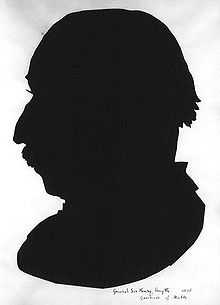Henry Augustus Smyth
From Wikipedia, the free encyclopedia
| Sir Henry Augustus Smyth | |
|---|---|
 Sir Henry Smyth, by Francis Smyth Baden-Powell | |
| Born |
November 25, 1825 St James's Street, London |
| Died |
September 19, 1906 (aged 80) Stone, Buckinghamshire |
| Buried at | Stone, Buckinghamshire |
| Allegiance |
|
| Service/branch |
|
| Years of service | 1841–1893 |
| Rank | General |
| Unit | Royal Artillery |
| Battles/wars | Siege of Sevastopol (1854–1855) |
| Awards | Knight Commander of the Order of St Michael and St George |
| Other work |
Justice of the Peace for Buckinghamshire, Fellow of the Society of Antiquaries, Fellow of the Royal Geographical Society |
General Sir Henry Augustus Smyth (1825–1906), KCMG, FSA, FRGS, was a senior British Army officer.
Military career
Educated at Bedford School, Smyth was commissioned as second lieutenant in the Royal Artillery in 1843.[1] He served in the Crimean War and was present at the Siege of Sevastopol.[1] He became commandant of Woolwich garrison and military district in 1882 and General Officer Commanding the troops in South Africa in 1886.[1] In 1888 Smyth mustered an army of 2,000 troops and left for Zululand to put down a rebellion there.[2]
Smyth became acting Governor of Cape Colony as well as acting High Commissioner for Southern Africa in 1889.[1] He became Governor of Malta in 1890 before retiring in 1893.[1]
Notes
References
- Vetch, R. H.; Lunt, James (reviewer) (January 2008) [2004]. "Smyth, Sir Henry Augustus (1825–1906)". Oxford Dictionary of National Biography (online ed.). Oxford University Press. doi:10.1093/ref:odnb/36174. (subscription or UK public library membership required)
- Attribution
 This article incorporates text from a publication now in the public domain: Vetch, R. H. (1912). "Smyth, Henry Augustus". In Sidney Lee. Dictionary of National Biography, 1912 supplement 3. London: Smith, Elder & Co. p. 352–353.
This article incorporates text from a publication now in the public domain: Vetch, R. H. (1912). "Smyth, Henry Augustus". In Sidney Lee. Dictionary of National Biography, 1912 supplement 3. London: Smith, Elder & Co. p. 352–353.
| Military offices | ||
|---|---|---|
| Preceded by |
GOC-In-Chief South Africa 1887–1890 |
Succeeded by |
| Government offices | ||
| Preceded by The Hon. Hercules Robinson |
Acting Governor of Cape Colony Acting High Commissioner for Southern Africa 1889 |
Succeeded by Henry Loch |
| Preceded by Sir Henry Torrens |
Governor of Malta 1890–1893 |
Succeeded by Sir Arthur Fremantle |
| |||||||||||
This article is issued from Wikipedia. The text is available under the Creative Commons Attribution/Share Alike; additional terms may apply for the media files.